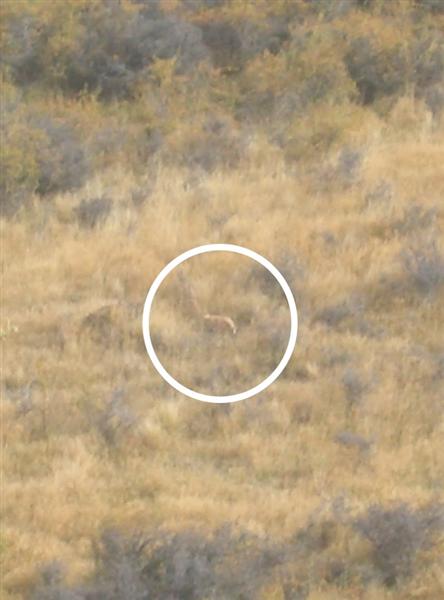
April 15, 2009
Is there a new image that is proof of a big ginger cat said to be “the size of a small lion” stalking the hills of the island nation of New Zealand?
As you may recall, a year ago, reports of a mystery cat, said to look like a “lion,” had the Northland of New Zealand as the seat of much excitement.
The giant alleged wild felid, dubbed the “Kaiwaka Lion,” was seen, for example, by Kaiwaka firefighter Allan Swanson’s son Carl, 18, during an urban search and rescue exercise in a quarry at Kaiwaka, 90 minutes north of Auckland, on May 29, 2008.
Today, April 15, in Australia, the talk is of a photograph that may show a “New Zealand lion.” (Just for the record, lions are not native to New Zealand.)
While it is difficult to tell if the cryptid is even a felid mystery animal vs a canid one, it is good to, at least, have obtained some form of photographic evidence. Or, perhaps, in this case, without scale, from a distance, does this just confuse closeup sightings of larger felines with an image of a small domestic cat?
What do you see in this photograph? What is it?

A pair of Scottish tourists were surprised when they saw and photographed this cat-like animal (circled), which they claim was similar in size to an Alsatian dog (called a German shepherd in North America), near McLeays Creek on the Lindis Pass, New Zealand. Photo by Charlie Limond.
The Himalayas had their Yetis, while Canada’s Sasquatch was known informally as “Bigfoot”.
And now, the Lindis Pass hill country may – or may not – have its “Big Ginge”.
Scottish tourists Charlie and Marie Limond photographed what they described as a “lynx-sized mountain lion”, at McLeays Creek in the Lindis Pass.
“It was definitely way bigger than your domestic cat. About the size of an Alsatian dog,” Mr Limond told the Otago Daily Times yesterday.
The couple were driving along State Highway 8, through the Lindis Pass, last week, when Mr Limond said he saw the animal “out of the corner of my eye”.
They turned their car around and said they watched the big cat, about 200m away, from the roadside for about seven minutes.
“I got a real good look at it through my binoculars. Our small digital camera wasn’t able to get a decent photograph, but it was the same goldy colour as a mountain lion,” he said.
Mr Limond was unshaken in his belief he had seen a “small lion-like animal”. He based his claims on having been to Africa and seen lions at game parks.
However, Wanaka Area Department of Conservation manager Paul Hellebrekers said the couple may have sighted an extremely large feral cat.
“There is nothing to substantiate that we’re not just dealing with a very large cat,” he said.
Dunstan Downs Station farmer Geva Innes laughed when the Otago Daily Times contacted her to ask whether there had been any reports of a “big ginger tomcat the size of a small lion” stalking the hills.
“We shoot feral cats round here,” she said.
The feral pests often roamed the hills and grew big. Feral cats could also carry the disease toxoplasmosis, which caused abortions in sheep, she said.
“Mystery animal snapped,” by Matthew Haggart, Wed, 15 Apr 2009
The Regions: North Otago
It’s Tax Day in America. My best to everyone going through this yearly spring ritual here. If you have an extra $10 left over, please know that amount from you builds to what we need to save the museum. Do remember to…
🙂 Thank You.
About Loren Coleman
Loren Coleman is one of the world’s leading cryptozoologists, some say “the” leading living cryptozoologist. Certainly, he is acknowledged as the current living American researcher and writer who has most popularized cryptozoology in the late 20th and early 21st centuries.
Starting his fieldwork and investigations in 1960, after traveling and trekking extensively in pursuit of cryptozoological mysteries, Coleman began writing to share his experiences in 1969. An honorary member of Ivan T. Sanderson’s Society for the Investigation of the Unexplained in the 1970s, Coleman has been bestowed with similar honorary memberships of the North Idaho College Cryptozoology Club in 1983, and in subsequent years, that of the British Columbia Scientific Cryptozoology Club, CryptoSafari International, and other international organizations. He was also a Life Member and Benefactor of the International Society of Cryptozoology (now-defunct).
Loren Coleman’s daily blog, as a member of the Cryptomundo Team, served as an ongoing avenue of communication for the ever-growing body of cryptozoo news from 2005 through 2013. He returned as an infrequent contributor beginning Halloween week of 2015.
Coleman is the founder in 2003, and current director of the International Cryptozoology Museum in Portland, Maine.
Filed under Alien Big Cats, Cryptid Canids, Cryptotourism, CryptoZoo News, Mystery Cats, Photos